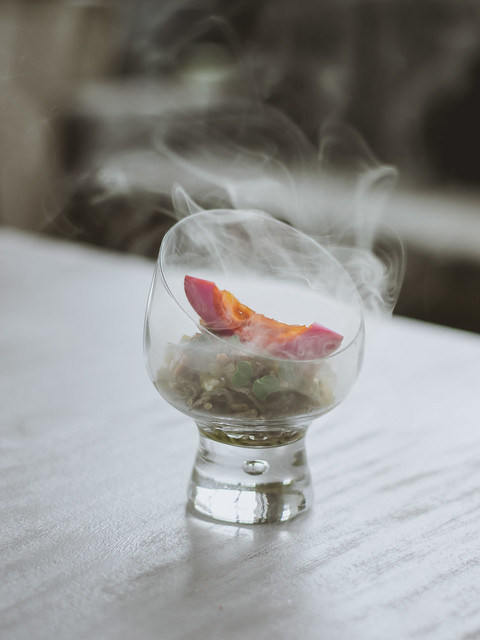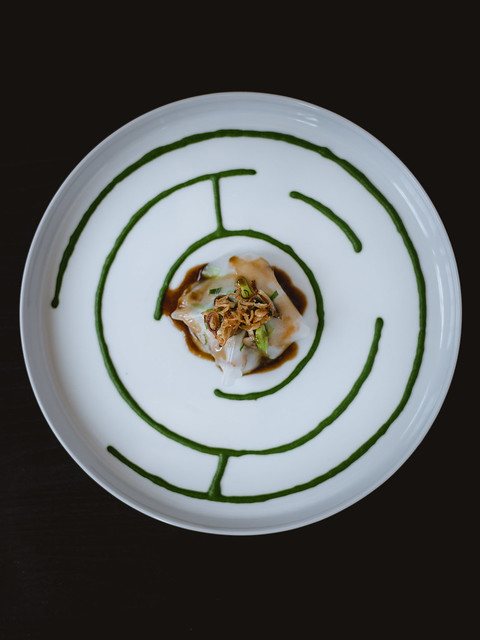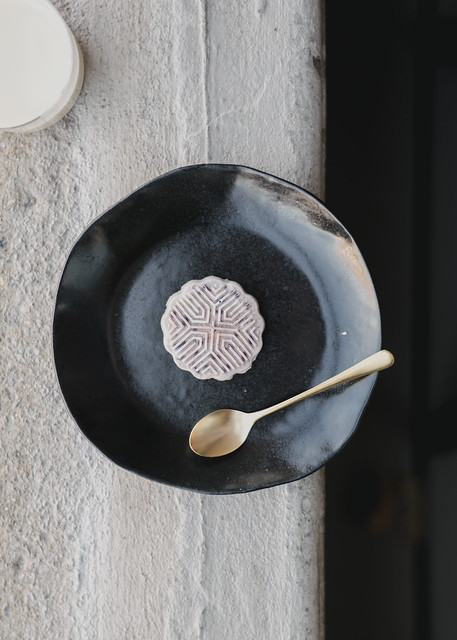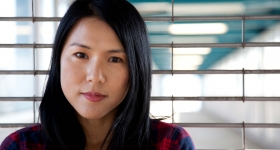Course One: You Make Asian Food, Right?

Black sesame & rye pasta, habanero chutney, “dim sum” clams, beet pickled egg, applewood smoke
The summer of 2012, I flew home to Seattle to cook the first and only meal I’ve ever made for my family.
It wasn’t a completely altruistic affair: I needed money to keep living in New York City, where my savings were being funneled into culinary school. It was imperative to wow them with something new, so I pulled out all the stops. Lamb chops, chicken breast with a frenched wing, tuxedo scallops, truffled mushrooms. That night, I attempted to line up the courses in order, but my father insisted on family style, so the five of us sat down for a concoction of everything all together.
My grandfather, still alive then, seemed the only one genuinely interested in all this adventurous food. Across the table, I watched him split a scallop into quarters and dip a piece into the demi-glace meant for the lamb chops. “I like this,” he announced in Chinese, mouth full and dentures on the table. “Don’t need teeth for this one.” To his right, my mother gave him the side eye before turning to me pleadingly and asked, “Why don’t you make more Asian food? You know we don’t care for this stuff.”
When it was time for graduation from the Institute of Culinary Education, I lied to my classmates and said that my family would be in China and couldn’t attend. In truth, I hadn’t invited them. The eight of them nodded understandingly and steered the conversation to our externship placements instead. Tim teased, “What fancy place are you headed to, Jenny?” The rest of them chuckled.
For how clearly they saw me, the administration certainly did not. I was too embarrassed to admit I had received my list of recommended externship sites the night before. Nestled between the short list of restaurants like Brooklyn Wok Shop, Koi and Annisa was a clear assumption: “You want to make Asian food, right?”
Four years and two starred restaurants later, I Skyped with a Food Network casting director, eagerly telling her about my signature dish: an earl grey and Sichuan peppercorn duck breast. It’s an examination of colonization, I was explaining when she interrupted me with a smile: “Let me tell you what we are looking for.” Her tone was firm. She didn’t have time for my tumultuous guilt, shame over lost loyalties or histories misunderstood, fighting the balance of self-actualization and group identity. She resumed with a bulleted list: “Wonton soup, fried rice, spring rolls, orange chicken.” A few seconds crawled by as I mentally weighed exploitation of my own culture for personal gain. I picked a dish from the fray and I felt like I was one giant lie, just waiting to be exposed.
***
My black sesame and rye pasta is an ode to the countless times I’ve been asked or implied: “You make Asian food, right?” There’s black sesame for grandpa, the flavor of his homemade morning porridge, mixed with rye flour that reminds me of my favorite Jewish deli. There’s a habanero sauce for spice — direct and fierce in a way my parents told me no Chinese girl should be. The habanero recipe has no Asian origins--it was taught to me by two women in Haiti, where I helped open an ice cream shop years ago.
Clams supply the salt and brine. I shuck and tuck them in the layers of pasta, surprise pieces of Chinese yore I recall fondly from Journey to the West and Romance of the Three Kingdoms. The last topping is an egg — sometimes quail, sometimes goose. It’s golden yolked, dripping in a way my parents would undoubtedly hate. Chinese food has many textures, but undercooked yolks is not one of them. But what it lacks on the inside, it has on the outside — it’s deceptively marbled, pickled instead of marinated.
And finally, smoke. Beautiful curls of applewood that breeze through like a kiss. They have no deeper meaning; they are empty and frivolous and that’s okay too.
Course Two: Model Minority

Veal sweetbreads in fried shallot crust, grilled celtuce, oyster mushroom, chrysanthemum puree, Shanghai sweet and sour sauce
During my pre-teen years, my mother began taking a vanpool to work. We lived in the suburbs of Seattle so I could attend a good school, and she hated driving. “People give me dirty looks,” she said of highway drivers. So every morning at 8:15 a.m., she would load up in a blue van with a group of scientists to the cancer research center.
In the summer, I’d squeeze in the back row with her, despite the fact that we were one of the last to be picked up. The morning commute was boring, but in the evening, the conversation was dominated by juicy complaints: funding being cut, grants being pulled, undeserving jerks from another department winning Nobel prizes. My mother had similar stories: her name was supposed to appear on multiple published works but was instead forgotten, her breakthrough research passed over for flashier subjects. But while her English was good enough to score perfectly on the TOEFL, in that car she was all but mute.
“I can’t believe that foundation picked Zhang’s lab over ours,” one scientist complained bitterly one night. He paused, clearly ruminating. “We’re overrun with Chinese scientists now. But at least we’ll never run out of technicians again!” He ends with a laugh, but it is far from genuine. He speaks in the direction of my mother to make sure she hears him. If there’s malice in his statement, she doesn’t acknowledge it. She just smiles at him, her slightly gapped front teeth shining against the evening light, her face hidden behind her hair and those dark freckles she always complained about.
I was still a little too young, and I didn’t quite understand. I didn’t know that my mother, who had advanced beyond a lab technician for years, still did the full range of work despite her promotions. She was the “shit sweeper” in the lab, and she kept at it, reminded everyday of an unfounded replaceability.
That night, my mother yelled at me for being so messy. She was right. My bedroom was a perpetual triage between the hamper and the floor. “How can you find a good husband if you’re so dirty?” she berated me. “Who is going to love you like this?”
“Maybe I don’t want to marry!” I began to cry. “Why are you so mean?!”
“I sacrifice for you everyday and you can’t even clean your bedroom!” She was also crying by then, and my father stepped in. I became afraid, and I jumped into action, grabbing strewn socks and straightening my sheets.
“Who do you think you are, talking back?” My father screamed. “We could kick you to the curb right now!”
Many years later, I would read an article about immigrant children internalizing their parents’ silence, misunderstanding their anger. About how their quiet acceptance and misplaced support of the painful status quo reshaped our American Dream.
***
This dish, the entrée and body of the meal, is a maze, a literal maze, trying to find meaning in far-flung promises. Chrysanthemum and celtuce, the primary vegetable flavors, are Chinese staples that have now become so popular that American chefs are laying claim to finding them altogether. No one speaks up. Acceptance and sacrifice is bound tightly together for the model minority, and I fall in line.
The star is veal sweetbread, an offal deemed acceptable, fancy even, by haute cuisine. In comparison, its lazy and ungrateful counterparts have received no such fanfare. It’s a deceptive aspiration for young Asian American women, searching for love from their families but through the eyes of a white society. A rice roll is made with agar and gelatin instead of typical glutinous rice, but still evocative of that slimy, slippery texture so off-putting to many. I hid this from my cooking for years, afraid to step out from behind my given place. And finally, sweet and sour sauce, fighting to reclaim itself. This is the Shanghai version and carries fonder memories of youth, dinners of my favorite sauced ribs and shepherd’s purse wontons. Always an eager eater, I would stuff myself as my mother said, “Don’t eat so fast. This food is like my love.”
Course Three: Fancy Because It’s French

Red bean mousse, homemade salted duck egg crème, oolong & white chocolate biscuit, served with homemade soymilk
My culinary classroom was a sweaty enclosure of people, pots and steam in the New York City summer.
My classmate was pacing behind me, growing more and more agitated as he rifled through the ingredient trays. “The recipe says shao … zing? What is that, wine? Oh good, this says it’s the same as sherry — I’m just going to use that.” He was not alone; everyone was hot and harried from attempting to cram all of our Chinese cooking curriculum into two days. Along with the Shaoxing wine, Stewarding overlooked the Sichuan peppercorn, white pepper and star anise, but our chef-instructor didn’t notice.
“Remember, the four regions of Chinese cuisine are North, South, East and West!” the instructor bellowed. Just last month, our emphasis had been terroir: the subtle, natural beauty of a certain landscape and the food that it yields. “You can taste the difference from which side of the Rhône the cow has grazed,” our instructor once described poetically. But now we’d moved on to Asia, and its subtleties were more nuisance than nuance.
“How do you even pronounce this stuff?” another classmate groaned out loud, tasting a spoonful of Zhejiang vinegar and making a face. His complaint was eerily similar to the thought I’d had almost every class until then, flushing with embarrassment as I'd tried to wrangle my tongue into the seemingly impossible shape of gougère.
As a last ditch effort, one classmate called me over to resuscitate his sweet and sour sauce. “Thank god we have one Asian person,” he laughed. “What am I doing wrong here?”
Before I could comment, my instructor appeared. “I know just what this needs,” he assured us. He left the room and returned with ketchup, an entire metal can of it. I felt the burn of indignation and shame as he began to ladle glop after glop into the sauce. Again, I found myself in the shoes of a perpetual bystander, subject to others’ interpretation of my heritage without any say of my own. As if sensing my discomfort, my instructor turned to me and gave his final ruling: “The best Chinese chef I know told me this is the secret to all your food.”
My culinary school never billed itself as a French-forward school. “We cover the international spectrum,” an admissions assistant informed me during my tour. But immediately the delineation was clear: being from a culture was no indication of being cultured. Context was everything. Lectures on bloomy rind cheese were no place to mention a similarly stinky Chinese fermented tofu curd, but discussions on additives were a great place to present a unified front against MSG. Our instructors spent weeks extolling the virtues of Normandy with its great apples and milk, the beauty of Provence and its lavender; as long as we acquiesced to their hierarchy, our overcooked sushi rice and sickly sweet pad thai were easily forgiven. I quickly learned acceptance comes in only one language — and it certainly wasn’t my native one.
***
For the dessert of this symbolic meal, I begin the contentious reconciliation of internal pride and external insecurity. I build from the flavors of a classic mooncake: red bean, salted duck egg, pastry shell, even the oolong tea my family typically pairs alongside it. Is it enough? Am I enough? A voice inside me answers, never.
So I take it apart, reworking every piece in a way I can’t walk back from, filling the void between the way I see myself and the way I am seen. The central yolk replaced with a gooey crème anglaise; the red bean “elevated” into a mousse; the kansui wrapper substituted with an oolong biscuit. Surely this version is somehow more refined, the same way those slender French silicone molds I’m using are more modern and deserved than the traditional wooden ones. Or maybe I’m just hiding from myself, my shame twisting into an identity that mocks my own mind as I search for some unreachable answer about how it feels to grow up somewhere but never belong.
Header photo: Liz Clayman. Food photos courtesy of the author.










Comments